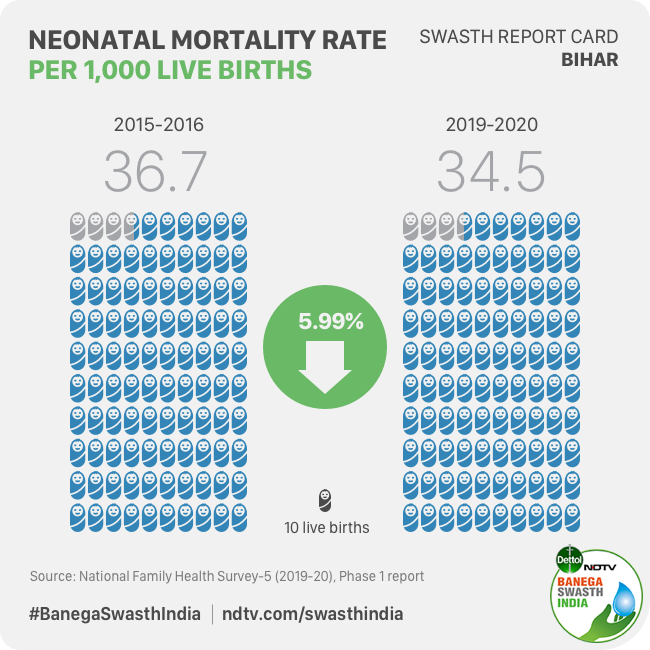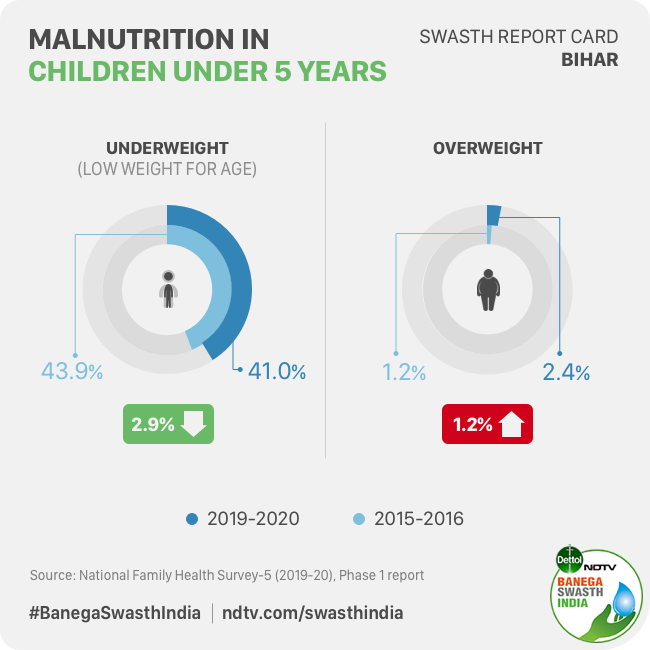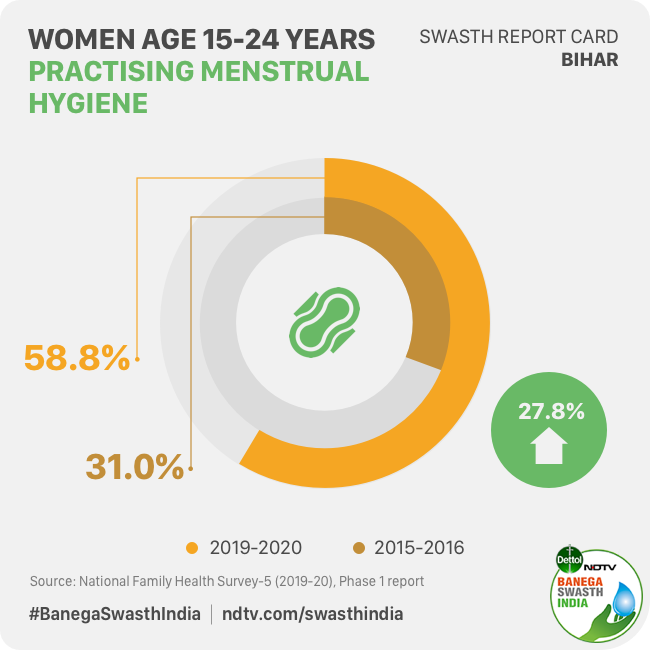Highlights
- Neonatal mortality rate (NNMR) in Bihar dropped by 5.99% in 4 years
- 69.4% children and 63.5% women in Bihar are anaemic: NFHS-5
- 22.9% children in Bihar are wasted as compared to 20.8% in 2015-16
New Delhi: Bihar government has taken various initiatives to bring down infant and child mortality rate by prioritising newborn care. Special newborn care units have been set-up in all the districts to provide special care in the initial days of the birth, according to Dr Syed Hubbe Ali, Health Specialist at UNICEF Bihar. As per the National Family Health Survey, 2019-20 (NFHS-5) phase 1 report released on December 12, infant and child mortality rate is on a decline in Bihar but at the same time, the state has reported an upsurge in anaemia, and some forms of malnutrition like percentage of overweight children in the state. NFHS-5 fieldwork for Bihar was conducted from July 9, 2019 to February 2, 2020 by Development and Research Services Private Limited (DRS). Information was gathered from 35,834 households including 42,483 women, and 4,897 men.
Here is a look at Bihar’s performance in NFHS-5 in terms of various health parameters:
Decline In Infant And Child Mortality Rate
The neonatal period is the first 28 days of a child’s life. The well-being of a child during this period depends on maternal and neonatal care including nutrition of both. Neonatal mortality rate (NNMR) per 1,000 live births in Bihar has witnessed a decline of 5.99 per cent when compared with the data of NFHS-4 conducted in 2015-16. The latest NFHS-5 conducted in 2019-20 shows that NNMR in Bihar stands at 34.5 per 1,000 live births whereas in 2015-16, it was 36.7 per 1,000 live births.
Infant mortality rate is calculated as the number of children dying under the age of one, per 1,000 live births. In Bihar, IMR is currently 46.8 per 1,000 live births as opposed to 48.1 per 1000 live births in 2015-16. Though IMR is following a downwards trend, the decline in the last four years is a mere 2.7 per cent.
Talking to NDTV about the initiatives taken by the state government to bring down the mortality rate among children, Dr Syed Hubbe Ali, Health Specialist at UNICEF Bihar, said, majority of the deaths in the state happen during the neonatal period or the first month of the birth or among premature children. He explained,
The government has taken many initiatives for neonatal survival like setting up special newborn care units (SNCU) every district by 2018. Bihar has 43 SNCUs and also new-born stabilization unit at the sub-district level. Institutional delivery has also increased drastically in the state and that has also helped in saving lives.
Under-five mortality rate (U5MR) is the probability of a child dying before completing the age of five. The U5MR in Bihar declined by 2.92 per cent, from 58.1 deaths per 1,000 live births in 2015-16 to 56.4 deaths in 2019-20, states NFHS-5 data.

The percentage of children dying before the age of 5 in Bihar has declined reveals NFHS-5 phase 1 report
Also Read: 115 Million Children Risk Malnutrition Due To COVID-19 Pandemic: India Child Well-being Report
NDTV spoke to Dr Sujeet Ranjan, Executive Director, The Coalition for Food and Nutrition Security (CFNS), to understand what helped Bihar in bringing down the infant and child mortality rate. Dr Ranjan said,
In Bihar, civil society organisations including self-help groups played an active role in supporting solutions at a local level, such as promotion of child care, nutrition to generate self-reliant populations, support capacity building efforts, nutrition security, and technology innovations in counselling, data collection and monitoring mechanisms. There is a significant reduction in early marriage and gender-based violence and an increase in women’s empowerment with financial power must have played an important role.
Increased Immunisation
The key findings of NFHS-5 phase 1 report show an improvement in full vaccination coverage among children aged 12-23 months, among those surveyed in Bihar. It has increased from 61.7 per cent in NFHS-4 to 71 per cent in NFHS-5. According to the Ministry of Health and Family Welfare, full immunisation implies vaccinating children with BCG (Bacille Calmette-Guerin) which is a vaccine for tuberculosis (TB), vaccines to prevent measles – MMR (measles, mumps, and rubella) and three doses each of polio (excluding polio vaccine given at birth) and DPT (diphtheria, pertussis, and tetanus).

NFHS-5 phase 1 report show an improvement in full vaccination coverage among children aged 12-23 months, among those surveyed in Bihar
Also Read: How To Safely Vaccinate Children During COVID-19 Pandemic
Infant And Child Feeding Practices Show Little Improvement
While the percentage of children exclusively breastfed till six months of birth has improved, early initiation of breastfeeding has declined in the state. It is recommended to initiate breastfeeding within one hour of birth, however, in Bihar only 31.1 per cent of the children surveyed under NFHS-5 were breastfed during the first hour. This is a decline of 3.8 per cent from 2015-16 when 34.9 per cent children were breastfed within one hour of birth.
According to WHO, children should be exclusively breastfed for the first six months and mothers in Bihar seem to be following this advice. The status of exclusive breastfeeding in the first six months of a child’s birth has improved from 53.4 per cent in 2015-16 to 58.9 per cent in 2019-20.
Also Read: Early Initiation Of Breastfeeding Declines In 12 States And Union Territories, Reveals NFHS-5 Report
Similarly, there has been an improvement in the percentage of breastfeeding children age 6-23 months receiving an adequate diet from 7.3 per cent in NFHS-4 to 10.8 per cent in NFHS-5.
Talking about the trends, Dr Ranjan said,
Bihar is one of the states where early initiation of breastfeeding (within one hour of birth). There is an improvement in children under six months of age being exclusive breastfed, complementary feeding, but it is not as per the efforts taken and needs more focus. Prevalence of diarrhoea and acute respiratory infection (ARI) has shown upward trends.
Nutritional Status Of Children
Nutritional status of children in a state is assessed on the basis of prevalence of malnutrition among children. In Bihar, stunting (low height for age) continues to drop since NFHS-3 conducted in 2005-06. Stunting among children under the age of five years has declined from 55.6 per cent (NFHS-3) to 48.3 per cent (NFHS-4) to 42.9 per cent now.
Gains made under child wasting (low weight for height) seem to be reversing as the prevalence of wasting among children of Bihar has increased in the past four years. In 2005-06, Bihar recorded child wasting at 27.1 per cent. Though in 2015-16 the figure dropped down to 20.8 per cent, in 2019-20 it is up again to 22.9 per cent.
Also Read: Despite Improvements In Health Services, Malnutrition Persists In West Bengal Finds NFHS-5
According to the WHO, child wasting stems from lack of nutrition and frequent infections like diarrhoea, pneumonia, among others. To avoid chances of child stunting and wasting, it is recommended to exclusively breastfeed the baby for the first six months. The growth of a child also depends on the well-being of a mother. If the mother is severely malnourished then the child’s growth and development will be adversely impacted.
Similarly, the percentage of overweight children in the state has doubled from 1.2 per cent in 2015-16 to 2.4 per cent now. Talking about this rise, Dr Ranjan said,
The rise in obesity is due to unhealthy food choices, lack of physical activities, unhealthy dietary habits, and excess calorie intake among children. In Bihar, limited availability of open spaces in urban areas and parks due to population expansion and illegal settlements with abundance of fast-food outlets and eating points, increased the chance of children becoming obese.
Only the prevalence of underweight children (low weight for age) seems to be declining in the state. Around 3 per cent fall was recorded from 43.9 per cent (NFHS-4) to 41 per cent in 2019-20.
Also Read: Swasth Guide: A-Z About Malnutrition And What It Entails
Anaemia Among Children And Adults Raise Concerns
Low Haemoglobin (Hb) levels in a human body is considered as anaemia. Experts believe anaemia can be acute to fatal. People with severe levels of anaemia may face cardiac attack and can die due to complications. Pregnant women, if anaemic, can witness impediments during delivery. In Bihar, anaemia among both pregnant and non-pregnant women and children age 6-59 months is on a rise. As per NFHS-5, in Bihar, 69.4 per cent children are anaemic as opposed to 63.5 per cent in NFHS-4.
Similarly, the data shows that women in the age group 15-49 years are widely affected by anaemia. 63.5 per cent of the women in the state are anaemic as per NFHS-5. An increase of 3.2 per cent has been recorded since NFHS-4 conducted in 2015-16, when anaemia prevalence was 60.3 per cent among women in this age group.

NFHS-5 phase-1 data shows that women in the age group 15-49 years in Bihar are widely affected by anaemia
Sharing his opinion on what can be done to bring down the levels of anaemia in the state, Dr Ranjan said,
The consumption of Iron Folic Acid during pregnancy has not increased significantly. Also, the coverage of antenatal care is still very poor. The role of civil society organisations, SHGs (self-help groups), Panchayati Raj Institutions can facilitate availability, accessibility, and counselling for proper utilisation of services, and build awareness on locally available foods, and promotion of appropriate dietary habits. The counselling of caregivers especially by frontline workers during home visits could contribute significantly to better anaemia control outcomes. This requires strong supporting supervision and monitoring system. The Inter Personal Communication (IPC) training with job aids and motivation of Anganwadi workers, ANMs (Auxiliary Nursing Midwifery) and ASHA on individual as well, family counselling needs to be further strengthened.
The silver lining is that the prevalence of anaemia among men has declined. As per NFHS-5 data, around 29.5 per cent of men surveyed are anaemic which is 2.8 per cent less than 32.3 per cent recorded during NFHS-4.
Also Read: How Haryana Is Fighting Anaemia And Improving Its Score Under Anaemia Mukt Bharat Campaign
More Women In Bihar Are Adopting Hygienic Method During Menstruation
NFHS-5 has revealed an uptick in menstrual hygiene among women between 15 to 24 years of age in 2019-20, compared to NFHS-4. Bihar saw a jump of 27.8 per cent in this area as 58.8 per cent of the women surveyed in the said age group were using hygienic methods of menstrual management as compared to 31 per cent in NFHS-4.
According to the Ministry of Health and Family Welfare, locally prepared napkins, sanitary napkins, tampons, and menstrual cups are considered to be hygienic methods of managing menstruation.
Also Read: This NGO Is Teaching People To Produce Reusable Sanitary Kits, Breaking Taboo Around Menstruation
Access To Improved Drinking Water And Sanitation Facilities
According to NFHS-5, 99.2 per cent of the sample population lives in households with an improved drinking water source which is better than 98.4 per cent in NFHS-4. According to the Union Health Ministry, the sources of drinking water include piped water in the residence or piped to neighbour, public taps, tube-wells, dug-wells, rainwater tanks, community RO plants among others.
Only 49.4 per cent of the population surveyed has access to improved sanitation facility, reveals NFHS-5. This is an increase of 22.9 per cent when compared to the population having access to toilets in NFHS-4 which was 26.5 per cent.
Improved sanitation facilities include flush to piped sewer system; flush to septic tank; flush to pit latrine; ventilated improved pit / biogas latrine; pit latrine with slab; twin pit / composting toilet that is not shared with any other household.
NFHS-5 noted a high urban-rural divide in access to improved sanitation facilities. 69.2 per cent of urban residents have access to improved sanitation facilities against only 45.7 per cent of rural population.
NDTV – Dettol Banega Swasth India campaign is an extension of the five-year-old Banega Swachh India initiative helmed by Campaign Ambassador Amitabh Bachchan. It aims to spread awareness about critical health issues facing the country. In wake of the current COVID-19 pandemic, the need for WASH (Water, Sanitation and Hygiene) is reaffirmed as handwashing is one of the ways to prevent Coronavirus infection and other diseases. The campaign highlights the importance of nutrition and healthcare for women and children to prevent maternal and child mortality, fight malnutrition, stunting, wasting, anaemia and disease prevention through vaccines. Importance of programmes like Public Distribution System (PDS), Mid-day Meal Scheme, POSHAN Abhiyan and the role of Aganwadis and ASHA workers are also covered. Only a Swachh or clean India where toilets are used and open defecation free (ODF) status achieved as part of the Swachh Bharat Abhiyan launched by Prime Minister Narendra Modi in 2014, can eradicate diseases like diahorrea and become a Swasth or healthy India. The campaign will continue to cover issues like air pollution, waste management, plastic ban, manual scavenging and sanitation workers and menstrual hygiene.
[corona_data_new]




























































